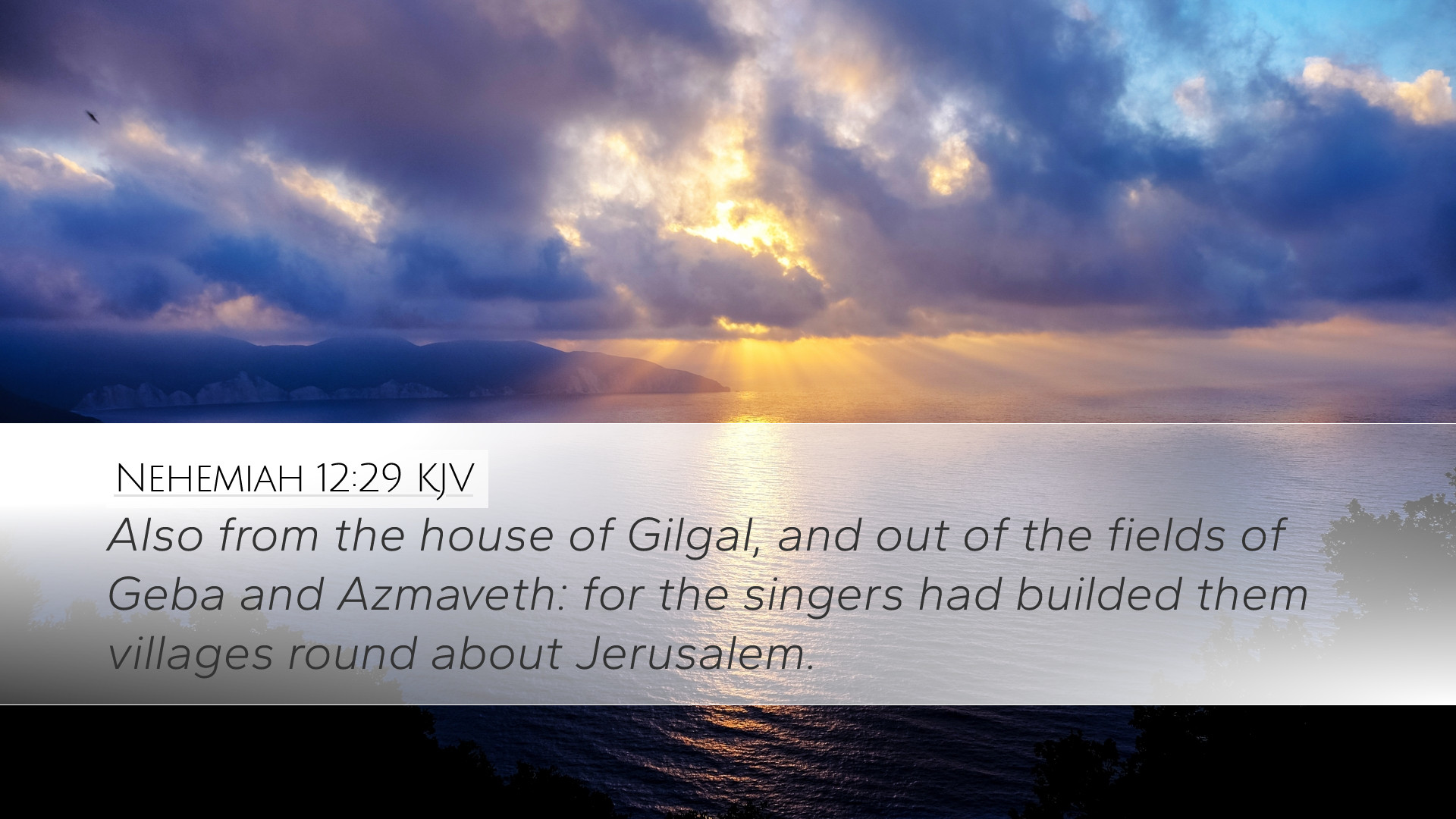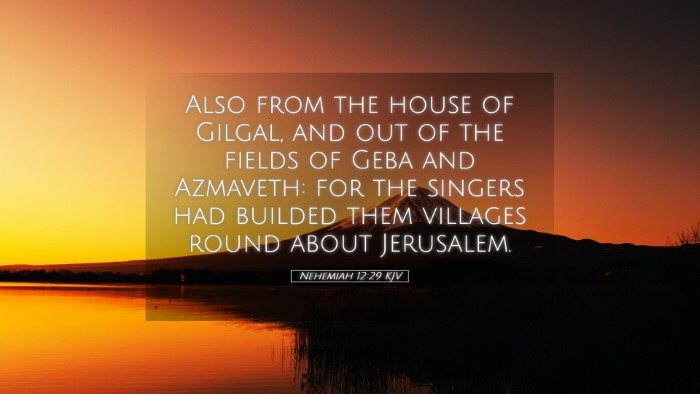Commentary on Nehemiah 12:29
Nehemiah 12:29 states:
“And from the gate of Joshua, which is over against the house of the new gate, shall be a collection of choirs, the one turning to the right hand and the other turning to the left.”
Introduction
This verse is part of the narrative detailing the joyous dedication of the wall of Jerusalem after its restoration. It highlights the importance of worship, community, and the structured praise of God, which is pivotal for understanding both the historical and theological implications within the context of Israel's restoration.
Historical Context
The context surrounding Nehemiah 12 illustrates a significant time in Israel's history, where the return from Babylonian exile and the rebuilding of Jerusalem was underway. Nehemiah, as the governor, played a crucial role in organizing the people for this monumental task. The reference to the "gate of Joshua" and the "new gate" hints at the geographical and spiritual state of Jerusalem during this period.
Insights from Matthew Henry
Matthew Henry emphasizes that this verse illustrates the organization of worship within the city. He notes the division of choirs signifies the communal aspect of worship; it is not a solitary act but a collective celebration. Henry expounds that the left and right positioning of the choirs also reflects the importance of balance in worship—public adoration of God should be passionate yet orderly.
Insights from Albert Barnes
Albert Barnes comments on the symbolism of the gates, particularly the "new gate," indicating both a physical and spiritual new beginning for the Israelites. Barnes points out that the choirs' arrangement from this strategic location symbolizes the outreach of worship and praise to all corners of Jerusalem. The act of praising God from such vantage points encapsulates the rediscovery of community identity and religious fervor.
Insights from Adam Clarke
Adam Clarke provides insight into the mechanics of the choirs' divisions. He remarks on the necessity of such structures in worship to evoke a greater sense of reverence and unity among the Israelites. Clarke elucidates that this systematized approach to worship is grounded in historical precedence, echoing practices found in earlier Israelite history. He highlights the textual evidence that supports the musical and liturgical traditions upheld within these gatherings.
Theological Implications
This verse carries substantial theological ramifications that extend beyond its immediate historical context. The traditional practices of gathering for communal worship underline a theological truth: worship ought to take place in tandem with community rather than isolated individualism.
The Nature of Worship
The structured choirs reflect the orderly nature of worship as a response to God’s grace. The gathering of the choirs at critical entry points like the new gate implies a transformative experience where worship leads to restoration and communal identification with God's covenant.
Community and Identity
The strategic alignment of these choirs shows how worship was used to solidify community identity post-exile. Nehemiah's leadership in mobilizing choirs highlights that the reestablishment of worship was foundational to the nation’s recovery of spiritual and cultural identity, as it unified the people toward a common purpose: glorifying God and acknowledging His faithfulness.
Praise as an Act of Witness
Praise and worship serve not only as an act of devotion but also as a powerful testimony to the nations. The arrangement of the choirs signifies that worship is an outward expression of what God has done. This notion would resonate deeply within the hearts of the Israelites and illustrate their societal role as light among the nations, a witness to the restoring power of God.
Practical Considerations for Today
Pastors, students, and theologians can draw practical applications from this verse and the surrounding context:
- Structured Worship: The organization within worship demonstrates the importance of having systems in place that facilitate communal engagement with God.
- Community Involvement: Active participation from the congregation is vital for spiritual vitality. Everyone has a role in the worship experience.
- Identity Formation: Emphasizing collective identities in the faith community can be crucial for transformation. Worship is cyclical, affirming community bonds and redirecting focus to God's purpose.
- Outreach through Worship: The visibility of praise serves as a public declaration of faith, influencing non-believers and drawing them into the community of faith.
Conclusion
Nehemiah 12:29 serves as a focal point in understanding the multifaceted role of worship within the context of Israel’s restoration. The insights developed through commentary from respected theologians like Matthew Henry, Albert Barnes, and Adam Clarke reinforce the significance of communal worship, structured praise, and identity in the life of a faith community. Modern readers, including pastors and theological students, can glean valuable lessons about the role of worship in shaping spiritual and community dynamics. This verse beckons all believers to consider how their shared experiences of worship can accelerate not only personal transformation but also collective witness in a world in need of hope.


